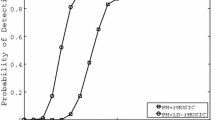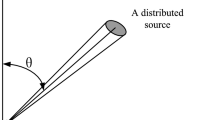Abstract
Subspace-based methods are very effective to estimate the direction of arrival (DOA) of sources with a high accuracy. In this paper, a method is proposed to estimate DOA of coherent signals without a priori knowledge of the source number, which is also suitable for independent or partly correlated sources, making the family of subspace-based methods more practical. The low-complexity autocovariance matrix is considered, and the spatial smoothing technique will be adopted to restore the column rank. In the case that the source number is unknown, the noise effect is eliminated with a specific noise estimation for coherent signals. A method combining the source number estimation and source localization is firstly presented. The corresponding analysis is given, and the weakness is shown. Then, another method is introduced to overcome the weakness, in which an improved propagator can be constructed to estimate the DOAs without the source number. The effectiveness is evaluated through simulations.









Similar content being viewed by others
Data Availability
The data used to support the findings of this study are included within the article.
References
M. Asghari, M. Zareinejad, S.M. Rezaei, H. Amindavar, Doa estimation of noncircular signals under impulsive noise using a novel empirical characteristic function-based music. Circuits Syst. Signal Process. 1–38 (2023)
H. Chen, Y. Li, W. Zhu, M.N.S. Swamy, W. Liu, Joint DOA and range estimation for mixed near-field and far-field strictly noncircular sources, in 2018 IEEE 23rd International Conference on Digital Signal Processing (DSP) (IEEE, 2018), pp. 1–5
F. Chen, C. Gui, S. Mo, Eigenvalue-based super-resolution DOA algorithm for arbitrary arrays. Appl. Acoust. 181, 108 106 (2021)
H. Chen, Z. Jiang, W. Liu, Y. Tian, G. Wang, Conjugate augmented decoupled 3-d parameters estimation method for near-field sources. IEEE Trans. Aerosp. Electron. Syst. 58(5), 4681–4689 (2022)
P. Chen, Z. Chen, B. Zheng, X. Wang, Efficient DOA estimation method for reconfigurable intelligent surfaces aided UAV swarm. IEEE Trans. Signal Process. 70, 743–755 (2022)
G. Chen, X. Zeng, S. Jiao, A. Yu, Q. Luo, High accuracy near-field localization algorithm at low snr using fourth-order cumulant. IEEE Commun. Lett. 24(3), 553–557 (2020)
J. Cai, E.J. Candès, Z. Shen, A singular value thresholding algorithm for matrix completion. SIAM J. Optim. 20(4), 1956–1982 (2010)
E.J. Candès, X. Li, Y. Ma, J. Wright, Robust principal component analysis. JACM 58(3), 1–37 (2011)
V.-S. Doan, D.-S. Kim, DOA estimation of multiple non-coherent and coherent signals using element transposition of covariance matrix. ICT Express 6(2), 67–75 (2020)
J. Di, Y. Li, L. Ma, D. Shen, C. Li, Convex optimization covariance matrix based on modified weighted spatial smoothing algorithm. Appl. Res. Comput. 37(11), 278–281 (2020)
J.E. Evans, D. Sun, J. Johnson, Application of advanced signal processing techniques to angle of arrival estimation in ATC navigation and surveillance systems. Massachusetts Inst of Tech Lexington Lincoln Lab, Technical Report (1982)
J. He, M.N.S. Swamy, M.O. Ahmad, Efficient application of MUSIC algorithm under the coexistence of far-field and near-field sources. IEEE Trans. Signal Process. 60(4), 2066–2070 (2012)
R. Lin, J. Mottershead, T. Ng, A state-of-the-art review on theory and engineering applications of eigenvalue and eigenvector derivatives. Mech. Syst. Signal Process. 138, 106536 (2020)
X. Li, W. Zhang, DOA estimation using virtual ESPRIT with successive baselines and coprime baselines. Circuits Syst. Signal Process. 1–11 (2020)
S. Marcos, A. Marsal, M. Benidir, The propagator method for source bearing estimation. Signal Process. 42(2), 121–138 (1995)
R.K. Olsson, L.K. Hansen, Estimating the number of sources in a noisy convolutive mixture using BIC, in International Conference on Independent Component Analysis and Signal Separation (Springer, Berlin, 2004), pp. 618–625
S.U. Pillai, B.H. Kwon, Forward/backward spatial smoothing techniques for coherent signal identification. IEEE Trans. Acoust. Speech Signal Process. 37(1), 8–15 (1989)
F. Pascal, L. Bombrun, J.Y. Tourneret, Y. Berthoumieu, Parameter estimation for multivariate generalized gaussian distributions. IEEE Trans. Signal Process. 61(23), 5960–5971 (2013)
C. Qian, L. Huang, H.C. So, Improved unitary root-MUSIC for DOA estimation based on pseudo-noise resampling. IEEE Signal Process. Lett. 21(2), 140–144 (2013)
S. Qiu, X. Ma, R. Zhang, Y. Han, W. Sheng, A dual-resolution unitary esprit method for DOA estimation based on sparse co-prime MIMO radar. Signal Process. 202, 108753 (2023)
D. Ramirez, G. Vazquez-Vilar, R. Lopez-Valcarce, J. Via, I. Santamaria, Detection of rank-\(p\) signals in cognitive radio networks with uncalibrated multiple antennas. IEEE Trans. Signal Process. 59(8), 3764–3774 (2011)
R. Roy, T. Kailath, ESPRIT-estimation of signal parameters via rotational invariance techniques. IEEE Trans. Acoust. Speech Signal Process. 37(7), 984–995 (1989)
R.O. Schmidt, Multiple emitter location and signal parameter estimation. IEEE Trans. Antennas Propag. 34(3), 276–280 (1986)
M. Wax, T. Kailath, Detection of signals by information theoretic criteria. IEEE Trans. Acoust. Speech Signal Process. 33(2), 387–392 (1985)
J. Xin, A. Sano, Computationally efficient subspace-based method for direction-of-arrival estimation without eigendecomposition. IEEE Trans. Signal Process. 52(4), 876–893 (2004)
Y. Yang, Z. Chu, G. Ping, Two-dimensional multiple-snapshot grid-free compressive beamforming. Mech. Syst. Signal Process. 124, 524–540 (2019)
W. Zuo, J. Xin, N. Zheng, A. Sano, Subspace-based localization of far-field and near-field signals without eigendecomposition. IEEE Trans. Signal Process. 66(17), 4461–4476 (2018)
W. Zhang, Y. Han, M. Jin, X. Li, An improved ESPRIT-like algorithm for coherent signals DOA estimation. IEEE Commun. Lett. 24(2), 339–343 (2019)
Acknowledgements
This work was supported in part by the Key-Area Research and Development Program of Guangdong Province under Grants 2021B0101310003, and National Natural Science Foundation of China under Grants 62001127. The authors declare that there is no conflict of interests regarding the publication of this article.
Author information
Authors and Affiliations
Corresponding author
Additional information
Publisher's Note
Springer Nature remains neutral with regard to jurisdictional claims in published maps and institutional affiliations.
Rights and permissions
Springer Nature or its licensor (e.g. a society or other partner) holds exclusive rights to this article under a publishing agreement with the author(s) or other rightsholder(s); author self-archiving of the accepted manuscript version of this article is solely governed by the terms of such publishing agreement and applicable law.
About this article
Cite this article
Li, J., Liu, D., Liu, Y. et al. An Improved Propagator Method for DOA Estimation of Coherent Sources Without the Source Number. Circuits Syst Signal Process 42, 6798–6812 (2023). https://doi.org/10.1007/s00034-023-02424-0
Received:
Revised:
Accepted:
Published:
Issue Date:
DOI: https://doi.org/10.1007/s00034-023-02424-0




